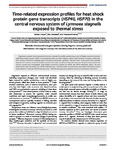Time-related expression profiles for heat shock protein gene transcripts (HSP40, HSP70) in the central nervous system of Lymnaea stagnalis exposed to thermal stress
| dc.contributor.author | Foster, Nicola | |
| dc.contributor.author | Lukowiak, K | |
| dc.contributor.author | Henry, TB | |
| dc.date.accessioned | 2018-03-29T11:06:07Z | |
| dc.date.available | 2018-03-29T11:06:07Z | |
| dc.date.issued | 2015-06-01 | |
| dc.identifier.issn | 1942-0889 | |
| dc.identifier.issn | 1942-0889 | |
| dc.identifier.other | e1040954 | |
| dc.identifier.uri | http://hdl.handle.net/10026.1/11211 | |
| dc.description.abstract |
Organisms exposed to environmental stressors respond by rapidly synthesising a suite of highly conserved proteins called heat shock proteins (HSPs). Environmental stress can also enhance and/or block memory formation, with longterm memory formation requiring gene activation and protein synthesis. Thermal stress in the pond snail Lymnaea stagnalis can enhance memory formation, and, in this study, the effect of thermal stress on HSP gene expression in the nervous system was investigated. Time-related expression profiles for HSP40 and HSP70 indicated rapid (<30 min) induction for both transcripts. For HSP40, induction was <20 fold relative to control and expression returned to control levels within 8 h, whereas HSP70 induction was >100 fold and expression did not return to control levels within 8 h. | |
| dc.format.extent | e1040954-e1040954 | |
| dc.format.medium | Electronic-eCollection | |
| dc.language | en | |
| dc.language.iso | en | |
| dc.publisher | Informa UK Limited | |
| dc.subject | environmental stress | |
| dc.subject | gene expression | |
| dc.subject | learning | |
| dc.subject | long-term memory | |
| dc.subject | pond snail | |
| dc.title | Time-related expression profiles for heat shock protein gene transcripts (HSP40, HSP70) in the central nervous system of Lymnaea stagnalis exposed to thermal stress | |
| dc.type | journal-article | |
| dc.type | Rapid Communication | |
| plymouth.author-url | https://www.ncbi.nlm.nih.gov/pubmed/26478775 | |
| plymouth.issue | 3 | |
| plymouth.volume | 8:3 | |
| plymouth.publication-status | Published | |
| plymouth.journal | Communicative & Integrative Biology | |
| dc.identifier.doi | 10.1080/19420889.2015.1040954 | |
| plymouth.organisational-group | /Plymouth | |
| plymouth.organisational-group | /Plymouth/Faculty of Science and Engineering | |
| plymouth.organisational-group | /Plymouth/Faculty of Science and Engineering/School of Biological and Marine Sciences | |
| plymouth.organisational-group | /Plymouth/REF 2021 Researchers by UoA | |
| plymouth.organisational-group | /Plymouth/REF 2021 Researchers by UoA/UoA07 Earth Systems and Environmental Sciences | |
| plymouth.organisational-group | /Plymouth/Users by role | |
| plymouth.organisational-group | /Plymouth/Users by role/Academics | |
| dc.publisher.place | United States | |
| dcterms.dateAccepted | 2014-08-19 | |
| dc.identifier.eissn | 1942-0889 | |
| dc.rights.embargoperiod | No embargo | |
| rioxxterms.versionofrecord | 10.1080/19420889.2015.1040954 | |
| rioxxterms.licenseref.uri | http://www.rioxx.net/licenses/all-rights-reserved | |
| rioxxterms.type | Journal Article/Review |


